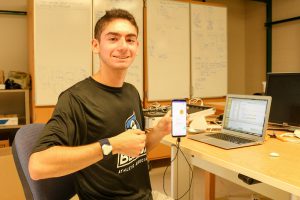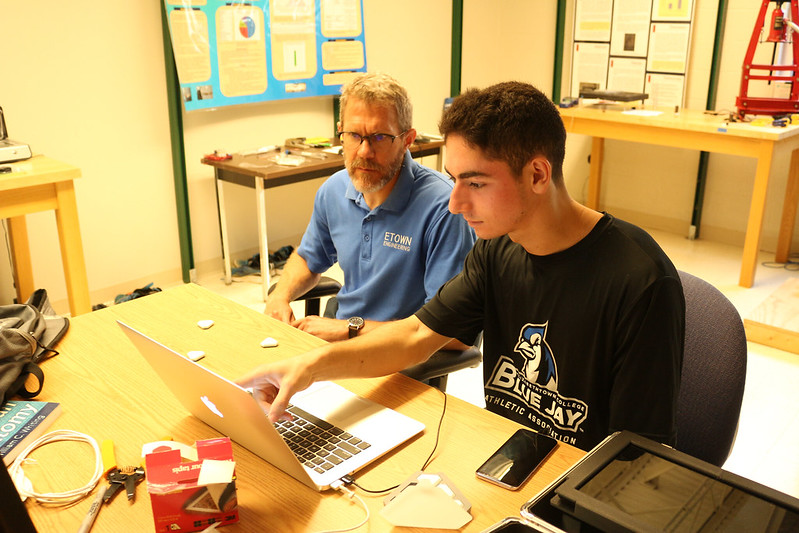An Elizabethtown College Physics and Mathematics student is spending his summer at Etown developing a mobile application that he hopes will revolutionize physical and occupational therapy through the use of wireless inertia sensors.
The independent student research and collaboration with an Etown faculty mentor is part of the Summer Scholarship, Creative Arts and Research Projects (SCARP) program.
Title of Research
E-MAT 2: Utilizing Notch® sensors
Student Researcher
Colin Elliot ’22 – Physics and Mathematics
Faculty Mentor
Kurt DeGoede, Professor of Engineering and Physics
What are you researching?
Colin: The purpose of the research is to create software capable of revolutionizing the way physical and occupational therapy is done by utilizing wireless inertia sensors. The inertia sensors can accurately identify their exact position in space. Hence, when they are attached correctly to a patient requiring therapy, they can provide precise data on the patient’s real-time motions. It is the goal of the software to leverage the power of the sensors to provide real-time feedback to the patient and to the therapist to ensure patients are performing prescribed exercises correctly and are restoring their range(s) of motion. For ease of access, this software comes in the form of a mobile application that one will be able to download from the Google Play Store and eventually the App Store. Although efficacy and practicality will be determined later in the clinics, the software appears to be very promising.
Why did you choose this topic?
Colin: Dr. DeGoede had previously done research creating software for physical/occupational therapy with older, wired sensors that worked on computers and Microsoft tablets, but we wanted a more intuitive and user-friendly way of providing real-time feedback to therapists/patients when doing therapy. Hence, we use wireless inertia sensors that are powered by an android mobile app one can download on their smartphone.
What is the most interesting aspect of this research?
Colin: It’s compelling to see how the wireless sensors can map a person’s bodily motions very accurately onto a phone screen in real-time. It’s cool to think that this project can be used in a variety of applications besides therapy including stretching, lifting, swimming, and helping people to better understand their form when exercising. It’s gratifying to know that this project can help anybody better understand their body.
How has Dr. DeGoede helped you throughout this experience?
Colin: Dr. DeGoede has been refreshing to talk to throughout this experience and has been a reservoir for great intellectual ideas.
Hear from the Faculty Mentor – Kurt DeGoede
“It has been a joy to work with Colin this summer,” said Dr. DeGoede. “He has been an independent worker and effective problem solver. I have challenged him to tackle a project in which he had no direct experience and he has worked through that project at an impressive pace. Despite obstacles, he is in a position to completely meet our objectives by the end of his 10 weeks. Colin will continue to support this work in the fall by working with a team of Occupational Therapy grad students utilizing the app Colin has developed for their clinical research project.
“The students that seek out summer research projects are highly motivated and purposeful in their work. Many continue on as full-time graduate students pursuing advanced degrees. The work in the biomechanics lab tends to be accessible for the undergraduate students and leads to direct insights or interventions in peoples’ lives – giving the students agency for serving others and using engineering to benefit society.”

